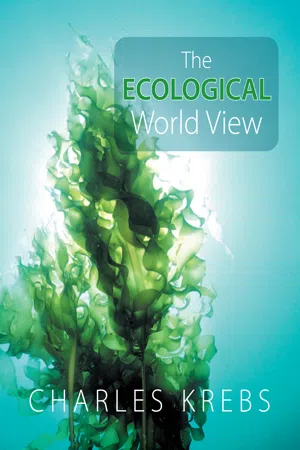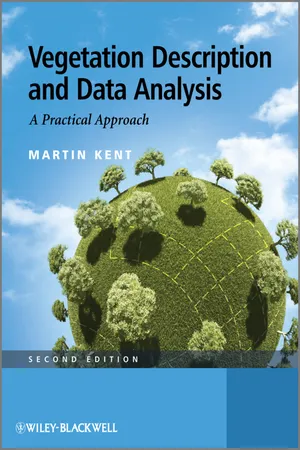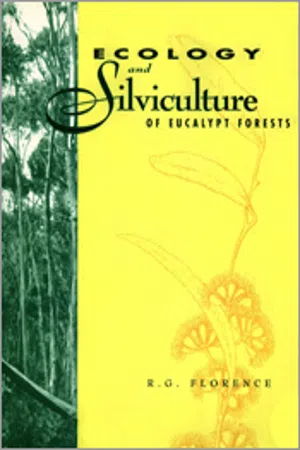Ecological Succession
Ecological succession refers to the process of change in the structure and composition of an ecological community over time. It occurs in a series of predictable stages, starting with pioneer species and leading to a more stable and diverse community. Succession can be primary, on newly formed land, or secondary, following a disturbance to an existing ecosystem.
8 Key excerpts on "Ecological Succession"
- eBook - ePub
30-Second Ecology
50 key concepts and challenges, each explained in half a minute
- Mark Fellowes, Becky Thomas(Authors)
- 2020(Publication Date)
- Ivy Press(Publisher)
...When these changes are predictable, we call this process Ecological Succession. Succession begins following a disturbance event that destroys some or all of the existing vegetation in a community. Examples include fires, hurricanes or even volcanic eruptions. Such disturbances create environmental conditions that are strikingly different from those found before the disturbance event occurred. Disturbances increase light availability, revitalize soil nutrients, create new microhabitats and remove competitors. These novel environmental conditions promote the colonization, germination and growth of species that would have been unable to persist in the pre-disturbance community. Generally, fast-growing and light-demanding grasses and wildflowers, called pioneer species, dominate early stages of succession. Eventually, these species are overtaken by slower-growing woody shrubs and trees that cast shade on the pioneer species. As succession proceeds, the diversity of the community generally increases as more species become established. Eventually, the slowest-growing and most competitive species become dominant, and the system is maintained until another disturbance event occurs. 3-SECOND SURVEY A successional community is one undergoing predictable changes in composition and diversity as a result of recovery from a disturbance event. 3-MINUTE STUDY The eruption of Mount St Helens, in the United States in 1980, offers a striking example of Ecological Succession. The explosion effectively destroyed all life within a 160-km (100-mile) radius of the eruption. In some areas, soils were completed removed, leaving only bare rock. Over time, a new soil substrate developed as early colonizers decomposed, allowing the establishment of hardy trees and shrubs...
- eBook - ePub
- Charles Krebs(Author)
- 2008(Publication Date)
- CSIRO PUBLISHING(Publisher)
...Succession is change and we will now consider how biological communities are organized and what mechanisms control their structure. SUMMARY Communities change over time and the study of succession has been an important focus of community ecologists for a century. Succession is the process of directional change in communities—the process of recovery from disturbances. Most of the work on succession has been done on plants, but the same principles apply to animal communities. Three conceptual models of succession have been proposed to explain the direction of vegetation changes. All models agree that pioneer species in a succession are usually fugitive or opportunistic species with a high dispersal rate and rapid growth. These pioneer species are replaced in three possible ways. The classical model states that species replacements in later stages of succession are facilitated by organisms present in earlier stages. At the other extreme, the inhibition model suggests that species replacements are inhibited by earlier colonizers and that successional sequences are controlled by the species that gets there first. The tolerance model suggests that species replacements are not affected by earlier colonizers and that later species in succession are able to tolerate lower levels of resources than earlier species. No single model explains an entire successional sequence. Ecologists now try to analyze succession as a dynamic process resulting from a balance between the colonizing ability of some species and the competitive ability of others. Succession does not always involve progressive changes from simple to complex communities. Succession proceeds through a series of seral stages from the pioneer stage to the climax stage. The monoclimax hypothesis suggested that there was only a single predictable end point for whole climatic regions and that, given time, all communities would converge to a single climatic climax community...
- eBook - ePub
Human Ecology
Basic Concepts for Sustainable Development
- Gerald G Marten(Author)
- 2010(Publication Date)
- Routledge(Publisher)
...6 Ecological Succession Natural processes continually change ecosystems. The changes can take years or even centuries, working so slowly that they are scarcely noticed. They have a systematic pattern generated by community assembly, following an orderly progression know as Ecological Succession, another emergent property of ecosystems. Ecosystems change themselves and people change ecosystems. People change ecosystems to serve their needs. Intentional changes by people can set in motion chains of effects that lead to further changes – human-induced succession. Sometimes changes are unintended. They can be unwanted and they can be irreversible. This chapter will give three examples of human-induced succession: Overgrazing and pasture degradation. Overfishing and replacement of commercially valuable fish by trash fish. Severe forest fires when forests are protected from fires. Since Ecological Succession can be of immense practical consequence, humans have responded by developing a variety of ways in which to integrate their use of ecosystems with the natural processes of succession. Modern society uses intensive inputs to maintain agricultural and urban ecosystems by opposing the natural processes of Ecological Succession. Many traditional societies have drawn on centuries of experimentation and experience to develop strategies that take advantage of Ecological Succession in ways that allow them to use fewer inputs. This chapter will describe examples from traditional management of village forests and traditional agriculture. Ecological Succession Do places with the same physical conditions always have exactly the same ecosystems? The answer is ‘no’. Firstly, random elements in biological community assembly can lead to different ecosystems. Secondly, ecosystems experience slow but systematic changes as community assembly proceeds. A single site has different biological communities, and therefore different ecosystems, at different times...
- eBook - ePub
Vegetation Description and Data Analysis
A Practical Approach
- Martin Kent(Author)
- 2011(Publication Date)
- Wiley-Blackwell(Publisher)
...In all parts of the world with seasonality of climate, the community changes with the seasons in terms of both presence of species and in their relative abundance. Over longer periods of time, community composition will often change according to the principles of succession and climax. Succession involves the immigration and extinction of species together with changes in their relative abundances. Primary succession occurs on bare ground where vegetation has not previously been found. Such sites are relatively small in extent on a world scale and are represented by landslips, new surfaces created by human activity or new volcanic islands emerging out of the ocean as in the case of Krakatoa in the Western Pacific in 1883 and Surtsey in the Atlantic, south of Iceland, in 1963. Several successive groups of species may invade as seral stages. Secondary successions occur when an established vegetation cover at a particular seral stage climax is removed or modified to an earlier seral stage, usually by some form of disturbance (Sousa, 1984; Pickett and White, 1985; Laska, 2001). The end product of succession is the climax community. Whereas succession implies changes in species composition through time, the climax concept is based on the idea of relative stability. The nature of climax communities has always been controversial. Clements (1916, 1936) was responsible for the original ideas of succession and climax, and it was he who first applied the terms sere, seral stage and climax to successional processes and plant communities. He also introduced the concept of the climatic climax, arguing that, ultimately, all communities in a given region come into equilibrium with the regional climate. For this reason, his ideas were known as the monoclimax theory. Tansley (1935) argued that observation of communities showed that, although in theory most vegetation might reach an equilibrium with climate, this was unrealistic because of the time periods required were so long...
- eBook - ePub
- RG Florence(Author)
- 2004(Publication Date)
- CSIRO PUBLISHING(Publisher)
...A number of plants may establish a simple community. Sometimes others may enter and displace some of the original species. Changes in the structure and composition of this community will normally be rapid at first, slowing gradually until a point of dynamic equilibrium or stability is reached. This process of continuing change in the community is called ‘Ecological Succession’ and is characteristic of all ecosystems. At one time it was held that following a severe perturbation all ecosystems would show succession to a single ‘climax type’ controlled by the regional climate, regardless of the original surface upon which the succession started or the composition of any intermediate stage. The classical doctrine of the regional or climatic climax stems largely from the writings of F. E. Clements (1916, 1936), and is based on two key assumptions: 1. Species replacement during succession occurs because populations tend to modify the environment, making conditions less favourable for their own persistence and leading to progressive substitution. 2. A terminal stabilized system, the climax, which is self-perpetuating and in harmony with the physical and biotic environment finally appears. Where applied to eastern Australia, this doctrine might regard rainforest as the ‘climax vegetation’. The succession towards rainforest might be slower on some sites than others, but ultimately a single, climax rainforest-type vegetation would be widespread. Partly because of the strong influence of this thinking, it was once widely held that different frequencies and intensities of fire were primarily responsible for much of the vegetation pattern in eastern Australia. The contribution of the physical environment to vegetation pattern was largely unappreciated...
- eBook - ePub
Second Growth
The Promise of Tropical Forest Regeneration in an Age of Deforestation
- Robin L. Chazdon(Author)
- 2014(Publication Date)
- University of Chicago Press(Publisher)
...It is likely that other forests like this one remain in the landscape—undetected—as they superficially appear to be “pristine” forests today. Secondary succession is initiated following a disturbance that removes all or most of the previous vegetation within a local area, leaving the soil relatively intact. Disturbances that initiate secondary succession include blow-downs from high winds, hurricanes, or cyclones, logging clear-cuts, fires, and forest clearances for agriculture or pasture establishment. But some types of disturbance have more dramatic effects than removal of vegetation. Volcanic eruptions cover extensive areas with pyroclastic deposits (see plate 7). During a major landslide, the side of a mountain can wash down into a valley. Fast-flowing rivers flood and erode riverbanks, creating new fluvial bars out of sediment and sand. Bulldozers remove topsoil and compact the mineral soil. These disturbances initiate primary succession, the gradual development of a plant community on bare soil or rock. The conditions created by such disturbances are inhospitable for the germination and establishment of most plant species. Landslides, volcanic eruptions, and river flooding have one aspect in common—colonists must establish on a newly created substrate. Previous soil has been washed way, eroded, or buried beneath sand, ash, rock, or lava. In this chapter, I show how tropical forests around the world have managed to become established on substrates lacking soil. The types of disturbances discussed in this chapter originate from natural causes. These natural “disasters,” as they have come to be called today, have always been present in the environment of tropical forests. Not surprisingly, many pioneer species that colonize early stages of primary succession also play a major role in early stages of secondary succession following forest clearance by human activities...
- eBook - ePub
Foundations of Ecology
Classic Papers with Commentaries
- Leslie A. Real, James H. Brown(Authors)
- 2012(Publication Date)
- University of Chicago Press(Publisher)
...We realize that all habitats are marked by continuous environmental fluctuation, accompanied or followed by a resulting vegetational fluctuation, but, in the common usage of the term, this is hardly to be regarded as an example of succession. But if the environmental change proceeds steadily and progressively in one direction, the vegetation ultimately shows a permanent change. Old species find it increasingly difficult or impossible to reproduce, as the environment approaches and finally passes their physiological demands. Some of the migrants find establishment progressively easier, as the environment passes the limit and approaches the optimum of their requirements. These are represented by more and more individuals, until they finally become the most conspicuous element of the association, and we say that a second stage of a successional series has been reached. It has sometimes been assumed that the various stages in a successional series follow each other in a regular and fixed sequence, but that is frequently not the case. The next vegetation will depend entirely on the nature of the immigration which takes place in the particular period when environmental change reaches the critical stage. Who can predict the future for any one of the little ponds considered above? In one, as the bottom silts up, the chance migration of willow seeds will produce a willow thicket, in a second a thicket of Cephalanthus may develop, while a third, which happens to get no shrubby immigrants, may be converted into a miniature meadow of Calamagrostis canadensis...
- eBook - ePub
Urban Nature Conservation
Landscape Management in the Urban Countryside
- Stephen Forbes, Tony Kendle(Authors)
- 2013(Publication Date)
- Taylor & Francis(Publisher)
...A fundamental tenet of plant ecology is the Competitive Exclusion Principle, which argues that under any given set of environmental conditions there will be one species that is physiologically and ecologically favoured and that would eventually come to dominate the community to the exclusion of all else. Diversity can only exist where there are factors that mitigate against the trend to monoculture. Not surprisingly several theories have been developed to attempt to identify these factors, and many of them make reference to the relationship between spatial distribution and temporal disturbance. Crawley (1986) identified the following main models, which he emphasizes are not necessarily mutually exclusive; indeed many are closely linked processes. The task of the ecologist is to determine which of these mechanisms have practical implications for the design, protection, and management of urban environments. Many of these models invoke mechanisms that prevent the plant community from reaching equilibrium, i.e. they assume that perfect competition is not possible in a community that is in some way disturbed. Environmental fluctuations allow species to grab transient opportunities before their competitors can reinvade or exert their full dominance. Other models attempt to identify processes or factors that can maintain species-richness within more stable ecosystems. The Lottery Model assumes that establishment microsites appear randomly, and that colonization is opportunistic and random, reflecting the timing and method of propagation relative to gap formation. Once established, the individuals may remain for a long time. Spatial Heterogeneity models suggest that apparently uniform areas do in fact contain many subtly different microsites that favour competition by different species...







